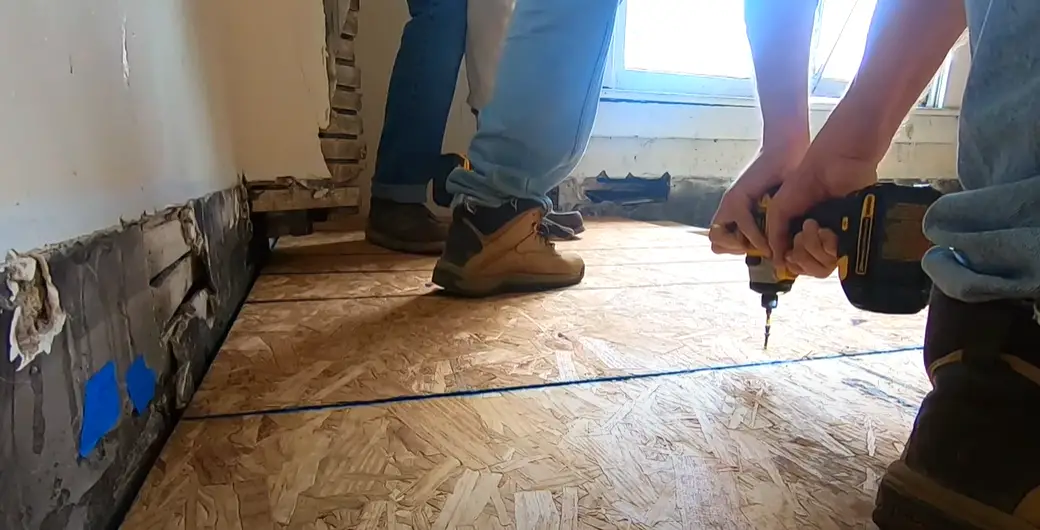If you’re lucky enough to live in an old house, you may find yourself faced with the challenge of leveling a floor. While it’s certainly not a task for the faint of heart, it is possible to level a floor yourself with a little patience and effort. Follow this step-by-step guide to learn how to restore an uneven floor in an older home with precision. With our guidance, you’ll have that floor looking good as new in no time!
Slanting/Sloping Floors vs. Sagging Floors
Older homes often have slanted or sloping floors, which can be a problem for homeowners. The primary cause of this is normal settling over time. This is due to the natural compression of soil beneath a foundation. A home’s floor may also slope because of changes in soil moisture and humidity, which can warp the joists supporting the flooring material.

On the other hand, sagging floors are typically caused by inadequate support or deterioration of the joists holding up the subflooring material.
Safety Considerations
Before you begin the leveling process, it is important to make sure that your work area is safe.
Make sure to wear protective gear such as eye protection and gloves when dealing with any potentially hazardous materials or tools.
Be aware of any potential health risks associated with dust created by the leveling process and take necessary precautions to avoid inhalation.
Make sure that your workspace is well-ventilated and free of clutter before beginning.
Additionally, inspect the old floor for any signs of structural damage or weakened joists which could pose a safety risk during the leveling process. If in doubt, consult a professional contractor who can assess the situation and advise accordingly.
Once you have taken proper safety precautions, you are ready to begin preparing your old floor for leveling. [1]
Fixing a Floor That Slopes or Slants
Place New Footers

When a floor is in disrepair and sags, the most reliable method of fixing it is to jack up the joists and place additional footers beneath them. This will help stabilize the joists, reducing any future shifting and sagging.
Lay Down Plywood Subflooring
Once your new footers are firmly set in place, you can lay down plywood subflooring as a level base upon which to install tile or hardwood flooring. Secure each piece of plywood with nails or screws at least every 8 inches along its edges. Do not leave gaps between pieces larger than 1/8 inch; fill these areas with small pieces of wood shims. Guarantee optimal results by employing superior materials.
Install New Flooring
After your subfloor is ready, you can begin laying the new flooring of your choice. Use quality materials for best results and be sure to follow all instructions provided by the manufacturer. If you are dealing with an old house, it is likely that there may be some areas where the floor isn’t level or which contain gaps between boards; use a patching compound or caulk to fill in any uneven spaces before installing the new flooring.
Finally, after completing your installation, inspect everything carefully and make sure that it is leveled and secure before moving on to other parts of the project.
Fixing a Floor That Sags and Dips
Smooth and Even Surface with Pour Self-Leveling Underlayment
The most efficient way to level a floor in an old house is by using self leveling underlayment. Self-leveling underlayment is a product designed specifically for this purpose and can be found easily at home improvement stores or online. It’s applied like concrete, but it levels and dries quickly, usually within 24 hours. To apply the product, first you will have to remove any existing floor covering from the area that needs to be leveled. After that, you should prepare the subfloor.

Sand and smooth down any rough spots and make sure there are no gaps between boards. Once the area has been prepped and cleaned, start pouring the self-leveling underlayment into the affected area starting at one end of the room. The product should be spread to an even thickness of about 1/4 inch.
After it has dried, you can apply a new floor covering such as tile or hardwood over the area. [2]
Add Plywood Sheets
If self-leveling underlayment isn’t an option for you, then you can also use plywood sheets to level your floor. This method is more time consuming and may require some carpentry skills, but it’s a good way to fix a sagging floor without having to rip out any existing flooring material. Start by measuring the depth of the dip in the affected area with a ruler and marking it on the subfloor. Then cut a piece of 3/4-inch plywood that’s slightly larger than the area that needs to be leveled.
Position the plywood sheet over the dip and secure it in place with construction adhesive. Once that has dried, you can nail or screw the plywood into place. After that, you can fill any gaps between the plywood sheets and subfloor with wood putty before adding your desired floor covering material.
Sister the Joists
If the dip in your floor is too severe for plywood sheets to be effective, then you may need to sister the joists. This method requires you to add another piece of timber alongside the existing joist and attach it together with screws or nails.
Start by measuring out the depth of the dip and marking it on the joist. Then cut a piece of timber that’s slightly longer than the marked line and position it against the existing joist. Secure it in place with either screws or nails and make sure they are evenly spaced apart.
Once both pieces have been attached together, use wood putty to cover up any exposed nail or screw heads before installing your desired floor covering material over top.
Prop Up the Joists
Before leveling the floor, it’s important to make sure that the joists (the beams underneath your floor) are properly supported. If they’ve rotted or broken, they may need to be replaced.
Lay Down New Hardwood
Once the joists have been properly supported, you can begin laying down a new hardwood floor. Hardwood is ideal for leveling floors in old houses because it is durable and comes in a variety of finishes to match your existing décor. When laying the new hardwood, make sure that each piece is secured securely with nails or screws and that it lines up perfectly with the other pieces around it.
How to Fill in the Low Spots?

Once you’ve determined the areas of your floor that need to be leveled, it is time to begin filling in these low spots. The material you use will depend on the size and depth of the spot. If it is a shallow area that just needs a skim coat of leveler or something similar, then this is usually the easiest and best option. However, if the area is large and deep then you may have to consider other options such as pouring concrete or self-leveling cement. It’s important to get the right material for your job so make sure to consult with an expert before proceeding.
No matter which type of filler you use, there are several steps involved in getting it installed properly:
1) Clean and prepare the area: Vacuum and sweep up any debris, then use a wire brush or cleaning solution to remove any dirt, grime, or paint that may be on the surface.
2) Apply primer: This will help ensure a better bond between the new material and the existing floor.
3) Mix and apply: Carefully follow the instructions for mixing your filler material so it applies correctly. Use a trowel to spread it evenly into the low spot. Let it dry as instructed before continuing with installation of other materials or walking on it.
4) Sand and finish: Once your filler is dried, sand down any ridges or bumps until you have created an even surface. Then finish with a sealant if necessary.
Following these steps will help you level your old house flooring with great results. With patience and the right materials, you’ll be able to achieve a beautiful and even surface that will last for years to come. [3]
How Do You Identify An Uneven Floor?
To identify an uneven floor, examine the surface closely and look for any dips, bumps or dips. You may even see light peeking through the floorboards in certain areas—an indicator of unevenness. If there are large gaps, you should take a level and check to see if the area is sloped.
Additionally, a marble can be used to test for slope on hardwood floors. Place it at one end of the room and observe which way it rolls; if it continues rolling in one direction then your floor is likely unleveled.
Another option would be to use a laser leveler. This tool uses an internal laser beam that projects onto the wall to measure for unevenness. It will alert you when two walls or sections of a room are not perfectly level. Once you have identified the unevenness in your floor, you can begin to take steps to level it.
To start, you need to determine why the floor is unlevel. This could be due to foundational shifting, water damage or simply wear and tear over time. Depending on the cause of the irregularity, different strategies may need to be used to even out the floors. It is important to identify any underlying issues before attempting any repairs so they can be addressed first.
Once you know what’s causing the issue and have identified where it’s located, it’s time to get started with leveling your floor. This can involve anything from shimming to leveling compounds. If the unevenness is minor, using a self-leveling compound may be enough. However, for more severe cases, it may be necessary to use floor jacks or other methods of structural repair. [4]
Why Are Uneven Floors Common in Old Houses?
Due to age and foundation settling, uneven floors are common in old houses. Uneven floors can be caused by a number of factors, including cracks in the foundation or subflooring that cause sections of the floor to sag or sink. Poorly leveled joists may also contribute to an uneven floor, as well as poorly installed plywood subflooring. In some cases, natural shifting and settling of a home’s foundation over time can also affect the levelness of its floors.

To create a safe and comfortable living space, you should make sure that your old house is properly leveled before finishing any new projects on the floor. [5]
FAQ
How do you level a badly unlevel floor?
The first step in leveling a badly unlevel floor is to determine the cause of the issue. If the floor has sagged or sunk due to age, it may be necessary to reinforce it from beneath with jacks and shims.
This process involves raising the floor from below so that it can be leveled from above. Once the underlying structure is secure, an appropriate leveler can then be applied on top of the floor surface. For best results, use self-leveling concrete or a similar product designed for this purpose. When applying any type of leveler, it’s important to follow directions carefully and allow ample time for drying before proceeding. Additionally, if dealing with an old house it’s important to check for electrical wiring, pipes, and other potential hazards before beginning the work.
What is the cheapest way to level a floor?
The cheapest way to level a floor in an old house is by using a self-leveling compound. Self-leveling compound is a mixture of Portland cement, sand and water. It can be applied over existing subfloor materials like concrete, plywood or OSB without the need to jack up the floor joists. Applying self-leveling compound is relatively easy and straightforward, however it may require several applications depending on how uneven the floor is.
After allowing each layer of the self-leveling compound to dry overnight, you should use a long straightedge such as a ruler or level to check for high and low spots before moving onto the next layer. The number of layers required will depend on how deep you need to go for the floor to be level.
How do you level a concrete floor in this old house?
The first step to leveling a concrete floor in an old house is to assess the floor’s existing condition. Look out for any uneven bumps and depressions, as well as cracks or damages to the concrete. It’s important to take note of these issues before attempting any repairs. The next step is to prepare the surface by cleaning it thoroughly. This can be done using a vacuum cleaner, broom, or damp rag. Ensure that all debris has been removed from the area before proceeding with the repair.
Once you have prepped the surface, you need to fill any cracks or holes with a cement-based material such as patching compound or mortar mix. You should apply several thin layers until the surface is even and level with the rest of the floor.
After the repair material has had a chance to dry, you can apply an epoxy or latex-based leveling compound over the entire area. This will help to create a smooth and uniform surface that is level with the existing concrete.
Once everything is level, you can leave it overnight for full curing before sanding down any excess material.
Are sloping floors in older homes normal?
Sloping floors in older homes are often completely normal and can be caused by a variety of factors such as settling or shifting foundations. While this may cause an inconvenience for some activities, it is generally nothing to worry about and does not usually require any further action.
How much does it cost to level floors in an old house?
The cost of leveling floors in an old house will depend on a number of factors such as the size and condition of the floor, the type of leveling material used and the complexity of any repairs needed.
Generally speaking, it can cost anywhere from $1-3 per square foot for basic repair work, to several hundred dollars for more complex jobs that require additional prep work or specialist equipment. It is always advisable to get several quotes before deciding on a contractor to ensure you are getting value for money.
Overall, it is possible to level a concrete floor in an old house with relative ease if done correctly.
Useful Video: How to level sagging floor in old house using shims, not floor leveler, in home renovation
Conclusion
Leveling a floor in an old house may seem like a daunting task, but with the right knowledge and tools, it can be relatively easy to accomplish. Make sure you understand all the steps involved before beginning your project, and take time to ensure that the new floor is completely level before continuing on with any further renovation projects. By taking these precautions, you will ensure that your floor is up to code and safe for your family to use. With patience and dedication, you’ll have a beautiful leveled floor in no time!
Good luck!
References
- https://www.thespruce.com/fix-sloping-sagging-and-unlevel-floors-1821649
- https://www.thisoldhouse.com/flooring/22397889/how-to-level-a-floor
- https://www.bobvila.com/articles/leveling-a-floor/
- https://homeguides.sfgate.com/determine-floor-level-36118.html
- https://www.rocketmortgage.com/learn/buying-a-house-with-uneven-floors














Leave a Reply